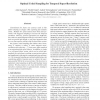Free Online Productivity Tools
i2Speak
i2Symbol
i2OCR
iTex2Img
iWeb2Print
iWeb2Shot
i2Type
iPdf2Split
iPdf2Merge
i2Bopomofo
i2Arabic
i2Style
i2Image
i2PDF
iLatex2Rtf
Sci2ools
CVPR
2010
IEEE
2010
IEEE
Optimal Coded Sampling for Temporal Super-Resolution
Conventional low frame rate cameras result in blur and/or aliasing in images while capturing fast dynamic events. Multiple low speed cameras have been used previously with staggered sampling to increase the temporal resolution. However, previous approaches are inefficient: they either use small integration time for each camera which does not provide light benefit, or use large integration time in a way that requires solving a big ill-posed linear system. We propose coded sampling that address these issues: using N cameras it allows N times temporal superresolution while allowing ∼ N 2 times more light compared to an equivalent high speed camera. In addition, it results in a well-posed linear system which can be solved independently for each frame, avoiding reconstruction artifacts and significantly reducing the computational time and memory. Our proposed sampling uses optimal multiplexing code considering additive Gaussian noise to achieve the maximum possible SNR in the recovere...
| Added | 02 Jul 2010 |
| Updated | 02 Jul 2010 |
| Type | Conference |
| Year | 2010 |
| Where | CVPR |
| Authors | Amit Agrawal, Mohit Gupta, Ashok Veeraraghavan, Srinivasa Narasimhan |
Comments (0)

